Hydroponics is the practice of growing plants in nutrient-rich water instead of soil. In this method, the fruits and vegetables are grown in planters (such as vermiculite, Rockwool, etc.), and the roots of the plant are surrounded by nutrient-rich water so that the nutrient & supplements can directly reach the plant. The supply of nutrient-rich water ensures that all the plants are healthy and grow quickly, resulting in higher yields and increased harvest frequency.
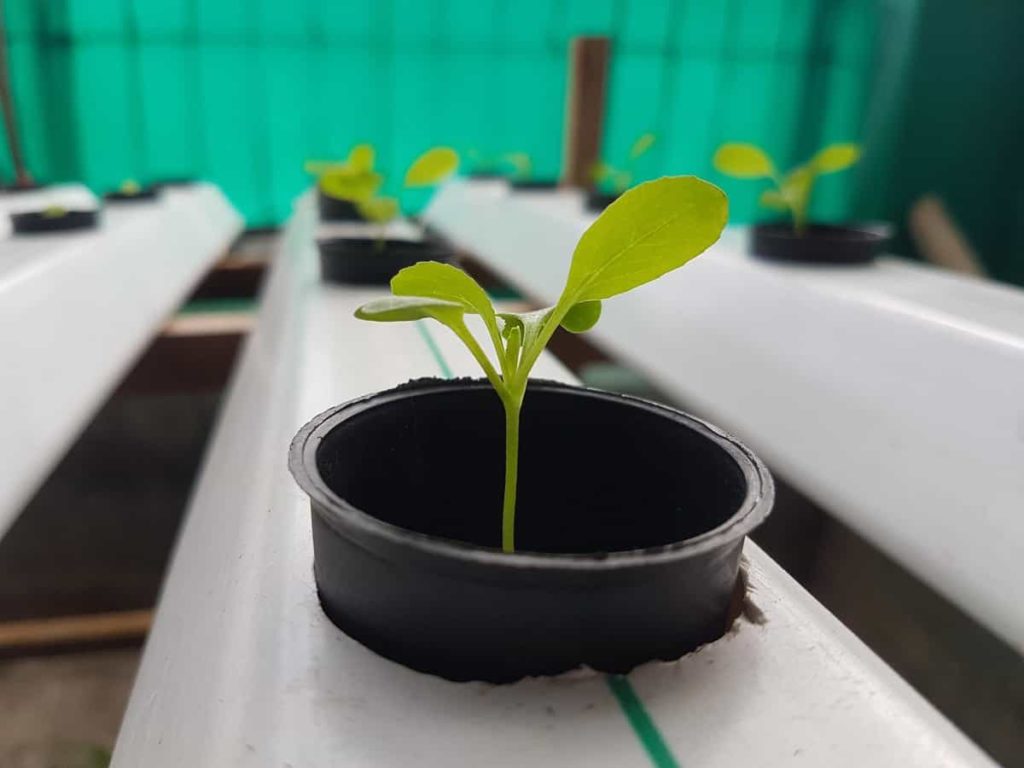
Hydroponics is carried out in a greenhouse or any enclosed structure so that all the elements which impact plant growth can be controlled and such an environment can be provided which are beneficial for plant growth. Hydroponics has been used since ancient times, and it was first used in the Hanging Gardens of Barcelona and later used in the Floating Gardens of the Aztecs of Mexico. The National Aeronautics and Space Administration (NASA) is also considering the practicality of using hydroponics for growing food in long-term space missions.
How to start Hydroponic farming in United Arab Emirates (UAE)
Benefits of using hydroponics
- Less volume of water is required: Hydroponics is a very sustainable method of growing crops. The water required under this method is approximately 80% less than the traditional farming method because the water is recycled and used again. The plants only use the necessary amount of water, and the excess water is challenged back to the reservoir. The water loss occurs only through evaporation or a leak in water channels.
- Soil-less cultivation: Unlike the traditional method of cultivation, the soil is not required for growing crops in hydroponics technology. The plants are grown using nutrient-rich water. Since the soil is not used, all the harmful pests (groundhogs, gophers, etc.) & microorganisms present in the soil cannot affect the plant. Additionally, agricultural activities such as soil preparation (before sowing the seeds) are not required, saving time, capital, and other resources.
- Healthy food: The plants grown using hydroponic technology are healthier than those grown under traditional methods because harmful chemicals and pesticides are not used. Additionally, plant-specific nutrition is used, which is directly absorbed by the plant. The number/quantity of nutrients required can be manually adjusted depending on the growth stage of fruits and vegetables. (For instance, strawberries need more nutrients at the initial stages of growth as compared to later stages)
- Higher production: In this method, the crops can be grown throughout the year because all the external factors such as temperature, rainfall, winds, etc., which hamper the growth of a plant are eliminated. All the requirements for plant growth are controlled; therefore, the plant can be grown throughout the year leading to higher and stable production.
- The volume of fruits and vegetables that will be produced in a year can be predicted, which helps the government in import planning
- The space and location of production of plants are more efficiently used if hydroponic is combined with vertical farming.
Why is hydroponics used on a large scale in UAE?
In Middle Eastern countries such as the United Arab Emirates, agriculture is not a dominant sector because the harsh climate, humidity, and non-availability of water act as a significant challenge. Hence, these countries depend heavily on the imports of food products. The United Arab Emirates imports approximately 80% of the total food required by the population. The high dependency on the import of food not only puts a big question on food security for UAE but also increases the cost of fruits and vegetables for people.
Additionally, since the food is imported, they are not fresh. In such a scenario, hydroponics is one of the most reliable and sustainable methods of agriculture. Furthermore, the harsh and humid climate of the country is no longer a challenge because the plants are grown in a controlled environment. Everything from temperature, air, humidity, nutrients, Ph level, etc., required for plant growth is manually controlled to provide a setting.
In case you missed it: 16 Key Rules for Effective Hydroponic Farm/Garden Management: From Planning to Reduce Production Cost
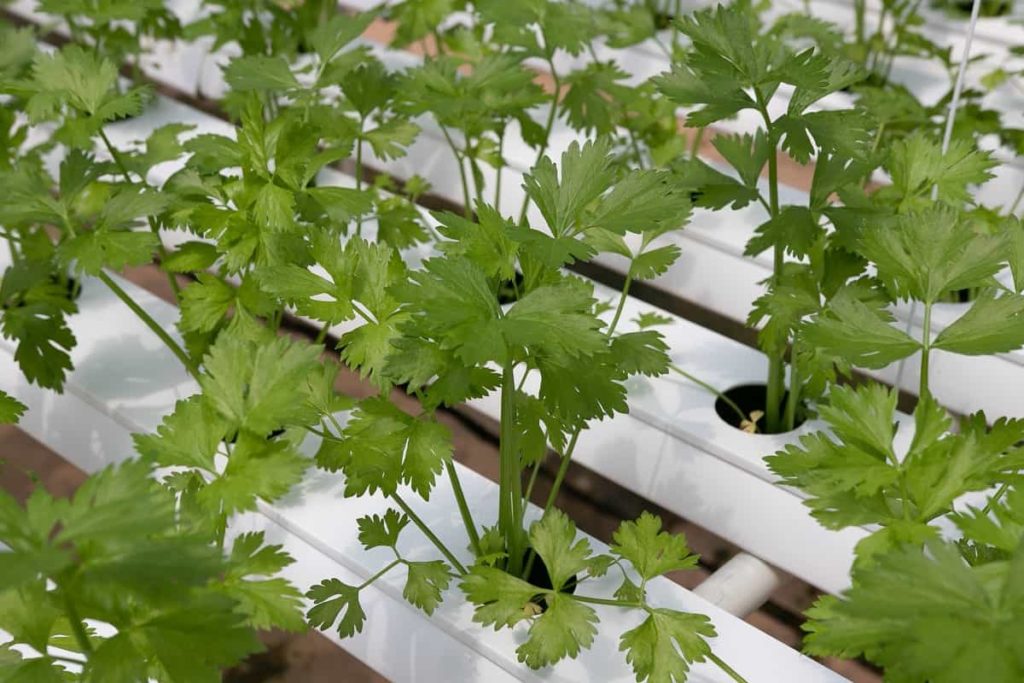
Water is a scarce resource in the UAE, and it acts as a significant challenge for the agricultural sector. Hydroponics uses very little water (approximately 70-80 % less water) for growing crops as compared to traditional farming. Only the required amount of water is used, and the excess is drained from the water channels. The water is reused & recycled, thereby reducing water requirement.
The government is taking numerous steps to promote this method of growing fruits and vegetables by looking at the advantages of using hydroponics. Also, the national airline of the UAE- “Emirates Airline,” has set up its hydroponic farm to serve fresh and organic food to its passengers.
Fruits and vegetables that can be grown in UAE using hydroponics
Several fruits and vegetables can be produced using hydroponic technology. However, choosing crops with a high sales volume is always beneficial to reach an early breakeven point. The initial cost of setting up a hydroponic plant is high, and growing crops with high turnover will help recover the cost incurred. The return on investment eventually increases.
In UAE, the central fruits and vegetables grown using hydroponic technology are chilies, cucumber, cherry tomatoes, bell peppers, strawberry, okra, blueberry, lettuce, spinach, thyme, kale, coriander, and numerous other leafy greens. In addition, some of the hydroponic firms in the UAE also produce animal feed such as corn, barley, and alfalfa.
Step-by-step process to open a hydroponic farm in UAE.
Legal requirements for opening a hydroponic plant
The first step required to open a hydroponic plant is to get legal clearance from the government of UAE and other relevant authorities. The Ministry of Climate Change and Environment (MoCCaE) is the legal authority regulating the country’s agricultural activity.
It is essential to obtain an agricultural license to carry out any agricultural activity (whether cultivation activities, trading of agriculture-related products, providing agriculture consultancy, carrying out the installation of greenhouse services, etc.). Therefore, the application for the issue of an agricultural license needs to be submitted to the ‘Department of Economic Development (DED).
A list of general documents that are required for setting up an agricultural business are:
- Commercial license or professional license.
- Map of the farm showing the area and location.
- A copy of the lease contract for the farm or proof of ownership of the site.
- Passport copy of partner/owner.
- Legal documents such as Memorandum of Association, Article of Association, Power of Attorney, etc.
- In some cases, the relevant authorities may require address proof.
- Some agricultural activities may at times require third-party approval.
Third-Party approvals
Depending on the restrictions, the authorities may also require third-party approval. Approval may be required from all or any of the following authorities:
- Ministry of Agriculture & Fisheries
- Ministry of Climate Change and Environment
- Public Health Services Department – Dubai Municipality
- Dubai Municipality – Food Control Department
In case you missed it: Home Hydroponic Farming for Beginners: Check How This Guide Helps to Start and Set up Soilless Garden from Scratch
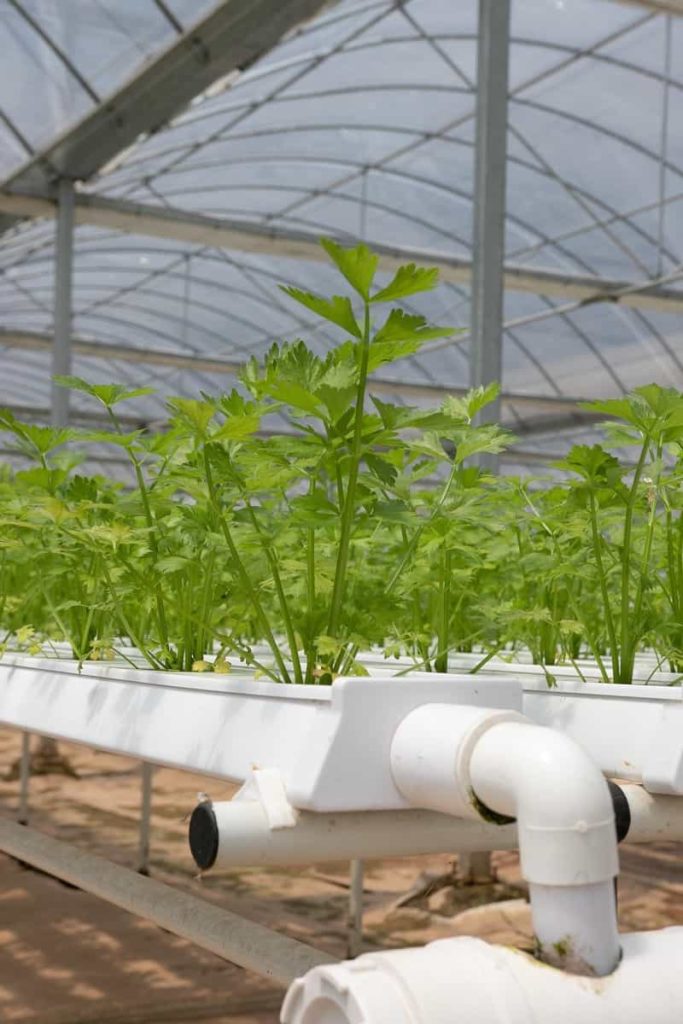
The other things which should be kept in mind before opening a new hydroponic farm are: sometimes the rules & regulations differ between emirates, the plant should be located near the road, and there should be an agriculture technician/engineer who has an agriculture activity license is. It is also mandatory to have a UAE residency visa for any agricultural activity.
In the case of organic farming, it is necessary to get confirmation from the ‘Emirates Authority for Standardization and Metrology (ESMA). First, ESMA conducts a Conformity Assessment, and after that, they issue a certificate.
Perform market analysis
It has been observed that the demand for organic food has tremendously increased post-COVID-19. This is because people have become health conscious and want to consume fruits and vegetables which have better nutrients and are grown without harmful chemicals. Therefore, the demand for salad vegetables such as cucumbers, cherry tomatoes, lettuce, kale, and mint has increased more than for vegetables such as okra, cauliflower, bell peppers, etc.
The Market segmentation of the UAE hydroponic method is based on type, equipment, input, farming method, crop type, competitional landscape, and regional distribution. The market analysis for hydroponic farms is an essential step since the set-up cost of the hydroponic plant is high. Some of the significant farms that have adopted the hydroponics method of growing fruits and vegetables are Wafra Farms, Badia Farms, Greenoponics Farms, UNS vertical farms, Al Aliyo Hydo Farms, Aranya Farms, Fresh Farm Harvest, etc.
Selection of the fruits and vegetables that will be grown in the hydroponic facility
It is essential to determine the fruits and vegetables that will be cultivated on the hydroponic farm. Numerous vegetation can be grown, such as basil, cucumber, cherry tomatoes, mint, coriander, thyme, chilies, etc. Animal feed such as barley, corn, and alfalfa can also be grown using hydroponics. However, the plants are grown on the farm also depend on the hydroponic method used.
For instance, green herbs such as lettuce grow well in deep water culture systems. On the other hand, shallow root plants such as kale, spinach, and strawberries grow well in the NFT method. Once the plant has been selected, the chosen seeds should be purchased.
Selecting the method to practice hydroponics
There are numerous hydroponic methods to choose from. Selecting the hydroponic method is crucial because the additional equipment required will depend on the method adopted. The different hydroponic methods are:
Nutrient film technique (NFT)
In this method, the plants are grown in a sloping hollow pipe, and the nutrient-rich water is pumped into those pipes. NFT is a closed system, and the water is first pumped to the pipes located at a higher level, and the water then flows down to the channels at the lower lever, thereby reducing the volume of water required.
Wick system
It is the simplest method for practicing hydroponics. Fabric such as nylon or cotton (wick) is attached to the plant root on one end, and the other end of the wick is dipped into the reservoir, which contains nutrient-rich water. The plant is provided water through the wick.
EBB and Flow
This method is known as the flood and drain. The water and the nutrients required by the plant are provided at frequent intervals. The water is supplied to the growing medium and then drained out so the roots can dry. The roots spread out in search of water when they dry out and absorb nutrients faster when water is supplied in the next interval.
In case you missed it: How to Start Hydroponic Farming/Gardening from Scratch in India: A Step-By-Step Guide for Beginners
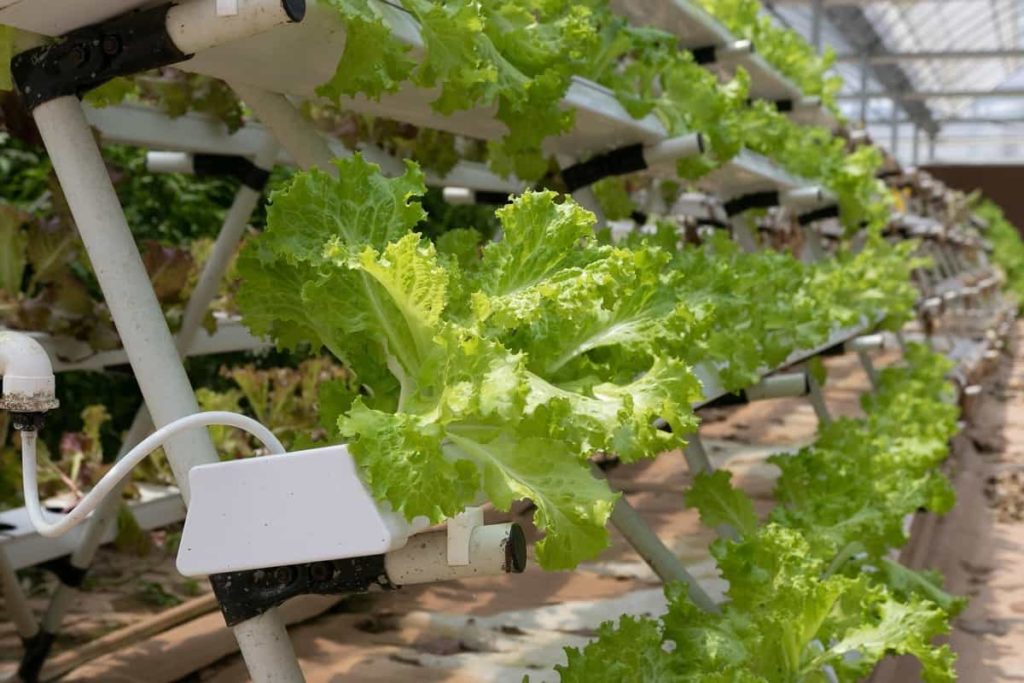
Deep water culture
In this method, the plant’s roots are dipped into the reservoir with oxygenated water. Oxygen is vital for plant growth, and since oxygen is provided to the reservoir, the roots are always dipped into the water tank.
Drip system
In this method, water is transported from the reservoir to the growing medium using a pump, and the small emitters/drips in the plant medium provide the nutrient water to each plant.
Aeroponic system
In this system, the plant roots are suspended in a chamber, and nutrient-rich water is either sprayed with fog or mist at intervals.
Equipment used in hydroponics
The number and type of equipment required for practicing hydroponics depend on the method of hydroponics adopted. The various types of equipment needed are:
Water: Water is essential for hydroponics because it provides nutrients to plants. People prefer distilled water for hydroponic systems because it has a neutral Ph level and is free from harmful chemicals. If groundwater /tap water is used, reverse osmosis filtration is essential to remove excess salt from the water. Reverse osmosis is necessary for UAE because of the high salt concentration in water. The water salinity for crops such as tomatoes and cucumber should be below 500ppm. Water quality should be monitored regularly to ensure adequate nutrients are maintained.
Fertigation system: The fertigation system is an automatic system with mixed nutrients according to the pre-determined formula. Mixing nutrients is done frequently depending on the crop type, growth stage, and temperature requirement. The fertigation system consists of a storage tank for fresh water, nutrient & chemical storage tanks, mixing tanks, meters to determine the level of Ph, pumps, wastewater collection tanks, irrigation system, control system, and water recycling system.
Water pumps are required to supply and circulate nutrient-rich water to the plants. In addition, water pumps help transfer water from reservoirs to the channels. Before buying water pumps, things that should be considered are delivery height, ease of maintenance, target flow rate, etc.
Water basins: Water basins are reservoirs used for storing water. The size of the basin directly depends on the scale at which the hydroponic farm is operating. For small plants, the minimum water requirement is half a gallon; medium plants require a minimum of 1 ½ gallon, and large plants require a minimum of 2 ½ gallons of water.
Water heater/chillers: One of the main advantages of hydroponics is that the water’s temperature can be controlled. The water temperature should be specific so the nutrients can be absorbed. The ideal temperature for absorbing nutrients is between 65-75 degrees Fahrenheit. However, different plants have different water temperature requirements.
Air pumps: Air pumps are one of the essential devices required in hydroponics. Air pumps are like ventilators that enhance the aeration of the roots. The air pumps help evenly distribute the oxygen because plants need oxygen to grow. The plant absorbs oxygen through nutrient-rich water. A few factors that need to be considered when purchasing air pumps are the reservoir’s size, the water’s temperature, the type of plant grown, the plant’s growth stage, airflow capacity, etc.
In case you missed it: Hydroponic Farming in USA: How to Start, a Guide for Beginners
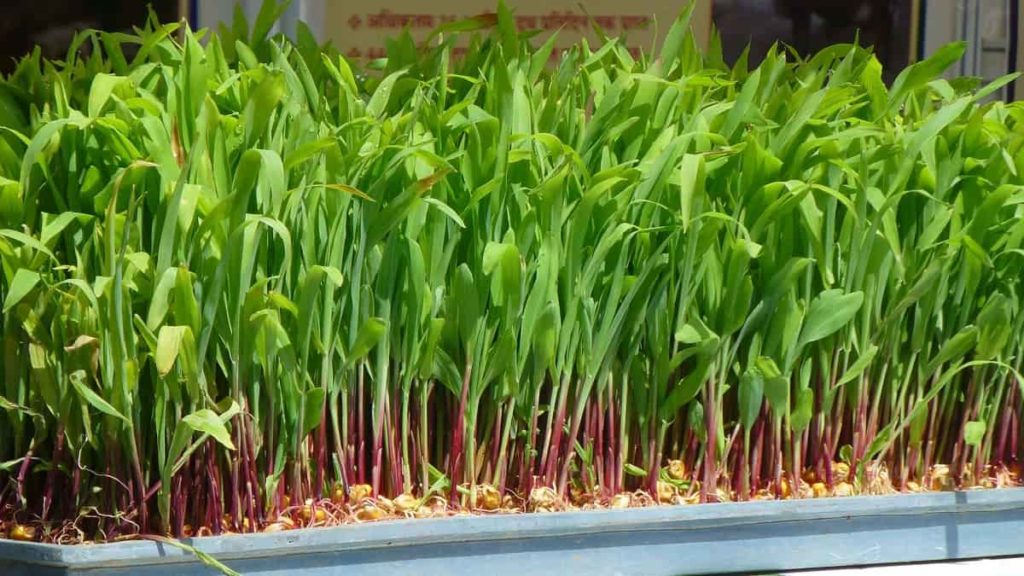
Timers and controllers: Timers and controllers are especially when a hydroponic system is automatic and where manual intervention is significantly less. Timers are used when specific activity needs to be performed at regular intervals. Some equipment that can be controlled using timers & controllers include ventilation and temperature control fans, grow lights and lamps, sprinklers, air conditioners, etc.
·Hydroponic tubes: Tubes are required for making the basic structure for plants to grow properly. There are two types of pipes that are required. One (vinyl tubing) is required to transport the water from the reservoir to the water channels. The other tube is larger tubes like PVC tubes which are used for building the structure of the hydroponic system.
Pots and trays: Pots and trays are used to grow plants. Some growers use rectangular or square pots because the space is effectively utilized in such pots, whereas others use circular pots (some space is left between two circular pots). The hydroponic pots and trays can be made from various materials such as plastic, clay, fabric, etc.
Hydroponic substrates: The substrates are used for growing the plants and help support the plant. They also provide the medium through which the nutrient-rich water will be absorbed. Substrates can be made from either organic material or inorganic material. Organic material substrates include sawdust, peat moss, sphagnum peat moss, coco peat, etc. Inorganic substrates include perlite, vermiculite, rock wool, sand & gravel, etc.
Fertilizers and nutrients: Fertilizers and nutrients are those chemical compounds necessary for plant growth. Nutrients are mixed into the water depending on the plant type, age, etc. The mix of nutrients is constantly monitored to ensure that the plants provide the required nutrients.
Inline/intake fans: Intake fans are used to maintain airflow within the enclosed structure. Stagnant air can harm hydroponics since it can cause humidity, dampness, etc., leading to the growth of pests and bacteria. Therefore, the intake fans are usually installed outside the greenhouse or enclosed structure to circulate the air.
In case you missed it: How to Get Hydroponic Farming Subsidy: Up to 50%, and License to Start
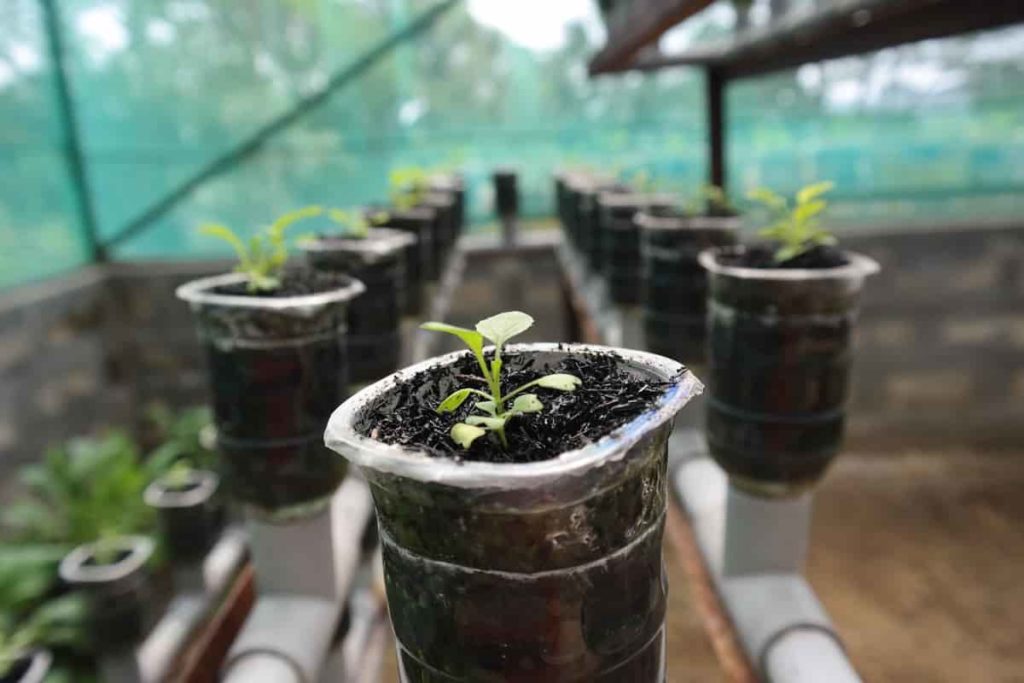
Light and various accessories: Plants need adequate light for their growth. Since hydroponics is carried out in enclosed structures, lights are used to provide the required amount of light. The light required can be controlled and changed depending on the plant type, the growth stage, etc. Typically, fruits require around 8 to 20 hours of sunlight per day. Some kinds of glow lights available are high-pressure sodium, fluorescents, metal, halides, ceramic halides, LED, etc.
Meters (EC, PH, Light intensity, PAR, DLI, temperature, humidity): Different types of meters are required in hydroponics to monitor and control the required environment, water salinity, temperature, humidity, light intensity, etc.
Knowledge about Ph level: The Ph level in water directly impacts the level of micronutrients in the water. The adequate Ph level of water required for plant growth is 5.2 to 5.5. To lower the Ph level of the water, nitric acid, phosphoric acid, and sulphuric acid can be used. To raise the Ph level, the use of acid should be stopped.
Average cost incurred for setting up a hydroponic plant: The minimum average cost of setting up a hydroponic plant in the UAE is approximately AED 2,50,000.
Conclusion
In summary, the hydroponic system benefits middle-eastern countries such as UAE, considering the harsh climate and non-availability of water. The hydroponic system addresses both challenges by providing a controlled environment. Considering the benefits of hydroponic, the government of UAE is taking measures to promote hydroponic farms. Therefore, any new entrepreneurs should consider the steps mentioned earlier.
- How to Make Houseplants Bushy: Effective Tips and Ideas
- Innovative Strategies for Boosting Coconut Pollination and Yield
- Pollination Strategies for Maximum Pumpkin Yield
- The Complete Guide to Chicken Fattening: Strategies for Maximum Growth
- Natural Solutions for Tulip Problems: 100% Effective Remedies for Leaf and Bulb-Related Issues
- Revolutionizing Citrus Preservation: Towards a Healthier, Greener Future
- Natural Solutions for Peony Leaf and Flower Problems: 100% Effective Remedies
- Maximizing Profits with Avocado Contract Farming in India: A Comprehensive Guide
- Natural Solutions for Hydrangea Problems: 100% Effective Remedies for Leaf and Flowers
- The Ultimate Guide to Choosing the Perfect Foliage Friend: Bringing Life Indoors
- From Sunlight to Sustainability: 15 Ways to Use Solar Technology in Agriculture
- The Ultimate Guide to Dong Tao Chicken: Exploring from History to Raising
- The Eco-Friendly Makeover: How to Convert Your Unused Swimming Pool into a Fish Pond
- Mastering the Art of Delaware Chicken Farming: Essentials for Healthy Backyard Flocks
- 20 Best Homemade Fertilizers for Money Plant: DIY Recipes and Application Methods
- How to Craft a Comprehensive Free-Range Chicken Farming Business Plan
- Brighten Your Flock: Raising Easter Egger Chickens for Beauty and Bounty
- How to Optimize Your Poultry Egg Farm Business Plan with These Strategies
- Subsidy for Spirulina Cultivation: How Indian Government Schemes Encouraging Spirulina Farmers
- Ultimate Guide to Raising Dominique Chickens: Breeding, Feeding, Egg-Production, and Care
- Mastering the Art of Raising Jersey Giant Chickens: Care, Feeding, and More
- Ultimate Guide to Raising Legbar Chickens: Breeding, Farming Practices, Diet, Egg-Production
- How to Raise Welsummer Chickens: A Comprehensive Guide for Beginners
- How to Protect Indoor Plants in Winter: A Comprehensive Guide
- Ultimate Guide to Grow Bag Gardening: Tips, Tricks, and Planting Ideas for Urban Gardeners
- Guide to Lotus Cultivation: How to Propagate, Plant, Grow, Care, Cost, and Profit
- Agriculture Drone Subsidy Scheme: Government Kisan Subsidy, License, and How to Apply Online
- Ultimate Guide to Raising Araucana Chickens: Breed Profile, Farming Economics, Diet, and Care
- Bringing Hydroponics to Classroom: Importance, Benefits of Learning for School Students
- Ultimate Guide to Raising Polish Chickens: Breed Profile, Farming Economics, Diet, and Care
- Ultimate Guide to Raising Australorp Chickens: Profile, Farming Economics, Egg Production, Diet, and Care
- Silkie Chicken Farming: Raising Practices, Varieties, Egg Production, Diet, and Care
- Sussex Chicken Farming: Raising Practices, Varieties, Egg Production, Diet and Care
- Homemade Feed Formulations for Livestock: Discover Cost-effective Starter to Finisher Feed Recipes
- 20 Best Pig Weight Gain Supplements: Top Swine Weight Gain Formulas
- Ultimate Guide to Elderberry Farming: Propagation, Planting, Yield, Cost, and Profit